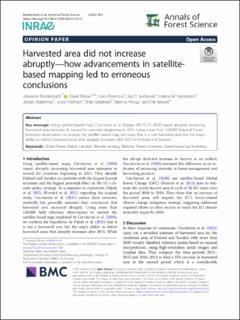| dc.contributor.author | Breidenbach, Johannes | |
| dc.contributor.author | Ellison, David | |
| dc.contributor.author | Petersson, Hans | |
| dc.contributor.author | Korhonen, Kari T. | |
| dc.contributor.author | Henttonen, Helena M. | |
| dc.contributor.author | Wallerman, Jörgen | |
| dc.contributor.author | Fridman, Jonas | |
| dc.contributor.author | Gobakken, Terje | |
| dc.contributor.author | Astrup, Rasmus Andreas | |
| dc.contributor.author | Næsset, Erik | |
| dc.date.accessioned | 2023-03-07T12:50:11Z | |
| dc.date.available | 2023-03-07T12:50:11Z | |
| dc.date.created | 2022-05-10T13:12:48Z | |
| dc.date.issued | 2022 | |
| dc.identifier.citation | Annals of Forest Science. 2022, 79 . | |
| dc.identifier.issn | 1286-4560 | |
| dc.identifier.uri | https://hdl.handle.net/11250/3056465 | |
| dc.description.abstract | Key message: Using satellite-based maps, Ceccherini et al. (Nature 583:72-77, 2020) report abruptly increasing harvested area estimates in several EU countries beginning in 2015. Using more than 120,000 National Forest Inventory observations to analyze the satellite-based map, we show that it is not harvested area but the map’s ability to detect harvested areas that abruptly increases after 2015 in Finland and Sweden. Keywords: Global Forest Watch, Landsat, Remote sensing, National Forest Inventory, Greenhouse Gas Inventory | |
| dc.language.iso | eng | |
| dc.title | Harvested area did not increase abruptly—how advancements in satellite-based mapping led to erroneous conclusions | |
| dc.title.alternative | Harvested area did not increase abruptly—how advancements in satellite-based mapping led to erroneous conclusions | |
| dc.type | Peer reviewed | |
| dc.type | Journal article | |
| dc.description.version | publishedVersion | |
| dc.source.pagenumber | 9 | |
| dc.source.volume | 79 | |
| dc.source.journal | Annals of Forest Science | |
| dc.identifier.doi | 10.1186/s13595-022-01120-4 | |
| dc.identifier.cristin | 2023104 | |
| dc.relation.project | Norges forskningsråd: 276398 | |
| cristin.ispublished | true | |
| cristin.fulltext | original | |
| cristin.qualitycode | 1 | |
